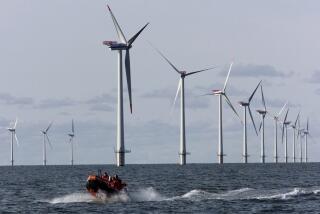WINDS OF CHANGE BLOW IN FROM D.C.
- Share via
WASHINGTON — The Interior Department will announce new rules today that clear the way for the first offshore wind turbines to be erected along the Atlantic Coast.
The rules will set long-awaited guidelines for offshore leases, easements and royalty payments that the Bush administration worked on for years but did not complete.
The guidelines represent the most aggressive move yet from an administration that hopes to shift the nation’s offshore energy supply from oil to wind power. President Obama is expected to mention the rules today in his Earth Day appearance at an Iowa wind turbine factory.
Offshore wind power is currently used to generate electricity in Europe, where land for traditional onshore turbines is scarce. There are no offshore wind farms in the United States.
The most prominent proposed development would be built on Nantucket Sound off Cape Cod, Mass. That project has been opposed by the Kennedy family and others in part because it would be visible from Martha’s Vineyard and other scenic areas.
The new rules reflect the administration’s desire to develop alternative energy sources to offset the need for additional offshore drilling for oil and gas.
As gas prices soared during last year’s presidential race, Obama and his Republican opponent, Arizona Sen. John McCain, both agreed to consider expanding offshore drilling, including along the California coast.
But since taking office, Obama has delayed a Bush administration plan to expand drilling while the Interior Department has focused on developing offshore wind power. The department recently estimated that offshore wind turbines could someday supply more than enough electricity to meet the nation’s current demand.
“There are many states, especially along the Atlantic seaboard, that are ready to move fast forward with this,” Interior Secretary Ken Salazar said in a recent interview. He said he saw offshore wind as having “significant potential” to round out an energy policy that includes clean-coal research, land-based wind and solar energy generation, and potentially more offshore drilling.
Offshore wind is an attractive energy source because the wind blows stronger and more consistently offshore. In addition, turbines off the Atlantic coast -- and, eventually, the Great Lakes and deeper waters off California -- would be near the population centers that use the most electricity.
But offshore wind turbines cost more than traditional wind turbines. Current technology also limits the turbines to shallower waters such as those found off the East Coast, which has less powerful winds.
The administration is trying to change that. The Energy Department plans to spend economic stimulus funds on research to improve offshore turbine blades.
At least two projects appear set to go -- a development by Massachusetts-based Cape Wind Associates and one by Deepwater Wind, in Rhode Island. Other projects in New Jersey, Delaware and New York are close behind.
The Cape Wind project has long been controversial but, thanks to backing from Massachusetts Gov. Deval Patrick and other state political leaders, appears poised for construction by the end of 2010.
Rhode Island officials have signed a deal with Deepwater for an offshore farm that could be finished within three years. The state hopes eventually to draw 15% of its electricity from offshore sources, said Andrew Dzykewicz, commissioner of Rhode Island’s Office of Energy Resources. Deepwater also has agreed to manufacture the pilings for the turbines in the state, creating an estimated 800 jobs.
Developers have also proposed projects in the Gulf of Mexico and in the Pacific Ocean, which boasts some of the nation’s strongest offshore winds. But those deep-water projects would be more expensive and require the turbines to be built on floating platforms.
“There’s definitely huge potential” on the West Coast, said Mike Dvorak, a Stanford University research assistant and engineering doctoral student who has studied California’s offshore wind conditions extensively. “But it’s more of a future game.”
--
More to Read
Sign up for Essential California
The most important California stories and recommendations in your inbox every morning.
You may occasionally receive promotional content from the Los Angeles Times.










